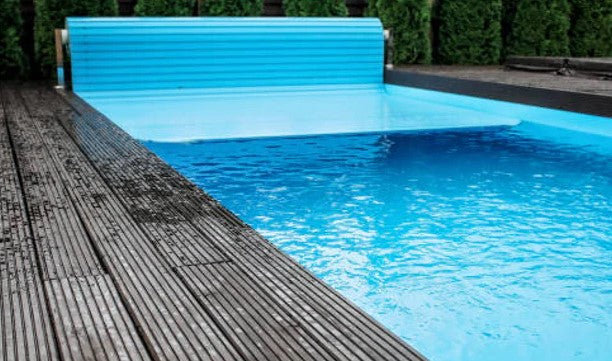Summer is just around the corner, and with it the desire to soak up the sun and take a refreshing dip in the pool. But before you dive headfirst into the water, it's important to remember that pool safety is a crucial issue, especially for children. In France, the law imposes strict regulations to guarantee the safety of users and avoid the risk of drowning.
Note: this article specifically speaks of the French regulation related to pool safety ; such regulation and rules depend on the country.
Safety requirements for private swimming pools in France
French legislation via articles L134-10 and R*128-1 to R*128-4 of the Code of Construction and Housing imposes safety requirements on private swimming pools, in order to prevent drowning accidents. These requirements mainly apply to private family pools, private communal pools, ‘natural’ pools, spas and jacuzzis; they do not apply to pools in supervised paid swimming establishments (if they comply with law 51-662 of 24 May 1951), or to indoor pools.
Which pools are concerned?
Private family pools
In-ground swimming pools
In-ground pools are the most common type of pool. They are generally made of concrete, polyester or wood. In France, these pools are subject to the obligation to install an approved safety device, whether they have already been built or are under construction.

In-ground pool
Semi-inground swimming pools
Semi-inground pools are partly in-ground and partly above-ground. They are often made of concrete or polyester. Like in-ground pools, these are subject to safety requirements in France. They must therefore have at least one approved safety device.

Semi-inground pool
Above-ground pools
Above-ground pools, most of which are made of steel, wood or plastic, are not subject in France to the obligation to install an approved safety device, but are subject to the ‘general safety obligation’ and must comply with the operating conditions expected of the product. However, as there is no such thing as zero risk, we strongly advise you to install a safety device, such as those for in-ground or semi-inground pools.
For more information, see our article on: How to secure an above-ground pool?

Above-ground pool
Private collective swimming pools
Private collective swimming pools, such as those at campsites, hotels or holiday villages, are also subject to safety standards. Compared with private family pools, they also have additional safety obligations in France:
- The floor and walls of the pool and beach must not be dangerous (slippery or abrasive).
- The instructions for use and precautions for use must be made available for all equipment provided and for all accessible attractions (slides, diving boards, etc).
- The minimum and maximum depths must be clearly legible from the beach and pool.
- The bottom of the pool must always be visible. Otherwise, it will have to be evacuated.
- The skimmers and return vents must be made safe so that they do not suck in the body or part of the body (fit a grille that cannot be opened by users). There must also be enough of them.
- Hydraulic installations such as intake vents, chutes or wave generators must have an easily accessible emergency shutdown system of the ‘mushroom head’ type.
Compulsory safety devices
To ensure the safety of your private pool in France, a safety system must be installed by you, the seller of the device or the installer of the device. In no way do the safety systems installed remove the need for active, permanent and constant supervision of young children.
You can choose one of the following systems that comply with the standards NF P 90-306, NF P 90-307, NF P 90-308 or NF P 90-309 recognised by French legislation:
The safety barrier (NF P 90-306 standard)
The safety barrier is mainly used when children are present and must comply with NF P 90-306 standard.
This standard includes the following obligations:
- The barrier must be at least 1.10 m high to block a child under the age of 5.
- The pillars, bars and all components of the barrier must not be abrasive or dangerous. There should be no raised areas, sharp edges, protruding parts or places where young children can get trapped.
- They must also withstand a shock of 50 kg.
- The unlock must be double-action to prevent it being opened by a 5-year-old child, while remaining easy for adults to open.

Pool safety barrier
The alarm (NF P90-307 standard)
The alarm must be able to detect any intrusion or fall into the water by a 5-year-old child. It must comply with the requirements of NF P 90-307-1 standard.
This standard includes the following requirements:
- The alarm must be fixed to the edge of the pool and must not be able to move; it must be able to withstand all weather conditions to ensure continuous protection and prevent unintentional triggering.
- It must be able to detect the fall of a child weighing 6 kg.
- The sound power generated must be 100 decibels at 1 metre away.
- The reactivation must be automatic to ensure constant protection and avoid forgetting to reactivate. It must be impossible for a child to activate or deactivate. It must also be able to provide information on the state of its batteries or in the event of a malfunction.
- It must not use prohibited radio frequencies.

Pool alarm
Covers (NF P90-308 standard)
Pool covers come in a variety of formats, including winter covers, safety nets and bar covers. A bubble cover is not a safety system that complies with the standard.
This standard includes the following obligations:
- Covers must be taut enough to not be able to lift more than 10 cm between each attachment point.
- The fastening system must resist a shock of 50 kg.
- The protection must be able to resist an adult weighing 100 kg.
- The fastening system must not be capable of injuring a child and must not extend more than 25 mm from the beach.
- For a swimming pool cover, the opening system must be at a height of more than 1.60 m or must require two consecutive actions in order to unlock it.
- For a swimming pool cover, the opening and closing system must face the pool to ensure that no-one gets in when closing or gets hurt when opening.

Pool cover
Shelters (NF P90-309 standard)
Pool shelters offer a number of advantages, such as maintaining water temperature, insulating against debris, etc.
This standard includes the following obligations:
- The structure of the shelter must be able to withstand a snow weight of 45 kg/m².
- The shelter structure must be able to withstand winds of 100 km/h.
- For a swimming pool shelter, the opening system must be at a height of more than 1.60 m or must require two consecutive actions to unlock it.
- The shelter must have passed the ageing and impact resistance test required by the certification.

Pool shelter
See also our article on: Who should install a swimming pool safety system in France?
Penalties and liability in the event of an accident
In France, in the event of non-compliance with the requirements or the absence of a safety system and in the event of drowning, the owner is solely liable under civil law for any damage caused to the victim:
- If they have committed unintentional recklessness, they are liable to a fine of €45,000 and 3-year prison sentence
- If they have committed wilful recklessness, they are liable to a fine of €75,000 and 5-year prison sentence
See more in our dedicated articles: Who is liable in the event of drowning in a private swimming pool? and What are the penalties if I don't install a safety system for my pool?
Safety requirements for public swimming pools in France
Public swimming pools, such as municipal pools, are subject in France to specific requirements that are stricter than those for private pools. These requirements can be found in the Sport Code, the Decree of 7 April 1981 on the Technical Provisions Applicable to Public and Private Collective Swimming Pools and the Decree no. 2021-656 of 26 May 2021 on the health safety of swimming pool water.
These obligations include:
- Supervision: public swimming pools must be supervised by qualified lifeguards during opening hours.
- Safety equipment: public swimming pools must be equipped with appropriate safety equipment, such as lifebuoys, safety ropes and defibrillators.
- Maintenance: public swimming pools need to be maintained regularly to ensure the quality of the water and the safety of bathers.
Specific requirements for greater safety
Public swimming pools receive a lot of people and are open all year round. That's why they have stricter safety obligations towards their public:
-
Mandatory signage:
- internal rules
- evacuation plan
- general instructions to be followed in the pools, showers and changing rooms
- types of clothing and objects authorised or not
- instructions for keeping common areas clean
- the qualifications and diplomas of the supervisors and their organisational plan
- The floor and walls of the pool and beach must not be dangerous (slippery or abrasive).
- The minimum and maximum depths must be legible from the beach and pool.
- Skimmers and intake vents must be secured so that they do not suck in the body or part of the body (fit a grille that cannot be opened by users). There must also be enough of them.
- Beach slopes must be between 3% and 5%.
- First-aid posts near the beaches.
- The capacity must be indicated at the entrance (3 people / 2m² of open-air water, 1 person / 1m² of indoor water).
- There must be constant supervision by state-qualified staff.
- Alarm instructions must be displayed and visible to users.
Strict standards for water quality
But you mustn't overlook the health risks involved in staying in the water. The water must be treated and comply with the following regulations:
- The pH must be between 6.9 and 7.7
- Combined chlorine must be less than 0.6 ppm (parts per million, i.e. the number of milligrams of chlorine per kilogram of water).
- Stabiliser-free water should have between 0.4 and 1.4 ppm active chlorine.
- Water with stabiliser should have between 2 and 5 ppm free chlorine
- Indoor pools must have an airborne trichloramine level of less than 75 ppm.
- If an ozonator is used for disinfection, the ozone level in the pool must be 0
- A minimum of 30 litres of new water per day and per rider is required.
Hygiene rules to be observed
To guarantee our own health safety, hygiene rules must be observed in public swimming pools. It is particularly important to:
- Shower before entering the water,
- Not eat or drink from the water,
- Not use greasy cosmetic products in water,
- Comply with the posted safety instructions.




Penalties and liability in the event of an accident
In the event of failure to comply with the legislation, the Prefect may issue a formal notice to the operator of the establishment to replace or improve the health and safety arrangements. Once this deadline has passed, the establishment may be closed temporarily or permanently. In an emergency, the establishment may be prohibited from opening, or even temporarily closed without prior notice.
By complying with safety requirements and hygiene rules, you can make the most of your time in the water, whether in a private or public pool. Don't hesitate to ask the professionals to ensure that your pool is compliant and that effective safety devices have been installed.




